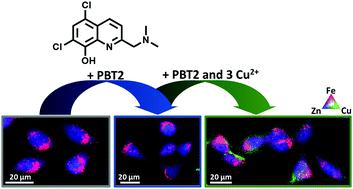当前位置:
X-MOL 学术
›
Metallomics
›
论文详情
Our official English website, www.x-mol.net, welcomes your
feedback! (Note: you will need to create a separate account there.)
PBT2 acts through a different mechanism of action than other 8-hydroxyquinolines: an X-ray fluorescence imaging study
Metallomics ( IF 2.9 ) Pub Date : 2020-11-2 , DOI: 10.1039/d0mt00222d Kelly L Summers 1 , Natalia V Dolgova , Kenneth B Gagnon , George J Sopasis , Ashley K James , Barry Lai , Nicole J Sylvain , Hugh H Harris , Helen K Nichol , Graham N George , Ingrid J Pickering
Metallomics ( IF 2.9 ) Pub Date : 2020-11-2 , DOI: 10.1039/d0mt00222d Kelly L Summers 1 , Natalia V Dolgova , Kenneth B Gagnon , George J Sopasis , Ashley K James , Barry Lai , Nicole J Sylvain , Hugh H Harris , Helen K Nichol , Graham N George , Ingrid J Pickering
Affiliation

|
8-Hydroxyquinolines (8HQs) comprise a family of metal-binding compounds that have been used or tested for use in numerous medicinal applications, including as treatments for bacterial infection, Alzheimer's disease, and cancer. Two key 8HQs, CQ (5-chloro-7-iodo-8-hydroxyquinoline) and PBT2 (2-(dimethylamino)methyl-5,7-dichloro-8-hydroxyquinoline), have drawn considerable interest and have been the focus of many studies investigating their in vivo properties. These drugs have been described as copper and zinc ionophores because they do not cause metal depletion, as would be expected for a chelation mechanism, but rather cellular accumulation of these ions. In studies of their anti-cancer properties, CQ has been proposed to elicit toxic intracellular copper accumulation and to trigger apoptotic cancer cell death through several possible pathways. In this study we used synchrotron X-ray fluorescence imaging, in combination with biochemical assays and light microscopy, to investigate 8HQ-induced alterations to metal ion homeostasis, as well as cytotoxicity and cell death. We used the bromine fluorescence from a bromine labelled CQ congener (5,7-dibromo-8-hydroxyquinoline; B2Q) to trace the intracellular localization of B2Q following treatment and found that B2Q crosses the cell membrane. We also found that 8HQ co-treatment with Cu(II) results in significantly increased intracellular copper and significant cytotoxicity compared with 8HQ treatments alone. PBT2 was found to be more cytotoxic, but a weaker Cu(II) ionophore than other 8HQs. Moreover, treatment of cells with copper in the presence of CQ or B2Q resulted in copper accumulation in the nuclei, while PBT2-guided copper was distributed near to the cell membrane. These results suggest that PBT2 may be acting through a different mechanism than that of other 8HQs to cause the observed cytotoxicity.
中文翻译:

PBT2 通过与其他 8-羟基喹啉不同的作用机制起作用:一项 X 射线荧光成像研究
8-羟基喹啉 (8HQ) 包括一系列金属结合化合物,这些化合物已被用于或测试用于多种医学应用,包括用于治疗细菌感染、阿尔茨海默病和癌症。两个关键的 8HQ,CQ(5-氯-7-碘-8-羟基喹啉)和 PBT2(2-(二甲氨基)甲基-5,7-二氯-8-羟基喹啉)引起了相当大的兴趣,并成为许多人关注的焦点。研究它们的体内特性。这些药物被描述为铜和锌离子载体,因为它们不会导致金属消耗,正如螯合机制所预期的那样,而是这些离子的细胞积累。在其抗癌特性的研究中,CQ 已被提议通过几种可能的途径引起有毒的细胞内铜积累并引发凋亡的癌细胞死亡。在这项研究中,我们使用同步加速器 X 射线荧光成像,结合生化分析和光学显微镜,研究 8HQ 诱导的金属离子稳态改变,以及细胞毒性和细胞死亡。我们使用溴标记的 CQ 同源物(5,7-二溴-8-羟基喹啉;B2Q)的溴荧光来追踪处理后 B2Q 的细胞内定位,发现 B2Q 穿过细胞膜。II )导致与单独的8HQ处理相比显着增加的细胞内铜和显着的细胞毒性。发现 PBT2 具有更强的细胞毒性,但比其他 8HQ具有更弱的 Cu( II ) 离子载体。此外,在 CQ 或 B2Q 存在下用铜处理细胞导致细胞核中的铜积累,而 PBT2 引导的铜分布在细胞膜附近。这些结果表明 PBT2 可能通过与其他 8HQ 不同的机制起作用以引起观察到的细胞毒性。
更新日期:2021-01-06
中文翻译:

PBT2 通过与其他 8-羟基喹啉不同的作用机制起作用:一项 X 射线荧光成像研究
8-羟基喹啉 (8HQ) 包括一系列金属结合化合物,这些化合物已被用于或测试用于多种医学应用,包括用于治疗细菌感染、阿尔茨海默病和癌症。两个关键的 8HQ,CQ(5-氯-7-碘-8-羟基喹啉)和 PBT2(2-(二甲氨基)甲基-5,7-二氯-8-羟基喹啉)引起了相当大的兴趣,并成为许多人关注的焦点。研究它们的体内特性。这些药物被描述为铜和锌离子载体,因为它们不会导致金属消耗,正如螯合机制所预期的那样,而是这些离子的细胞积累。在其抗癌特性的研究中,CQ 已被提议通过几种可能的途径引起有毒的细胞内铜积累并引发凋亡的癌细胞死亡。在这项研究中,我们使用同步加速器 X 射线荧光成像,结合生化分析和光学显微镜,研究 8HQ 诱导的金属离子稳态改变,以及细胞毒性和细胞死亡。我们使用溴标记的 CQ 同源物(5,7-二溴-8-羟基喹啉;B2Q)的溴荧光来追踪处理后 B2Q 的细胞内定位,发现 B2Q 穿过细胞膜。II )导致与单独的8HQ处理相比显着增加的细胞内铜和显着的细胞毒性。发现 PBT2 具有更强的细胞毒性,但比其他 8HQ具有更弱的 Cu( II ) 离子载体。此外,在 CQ 或 B2Q 存在下用铜处理细胞导致细胞核中的铜积累,而 PBT2 引导的铜分布在细胞膜附近。这些结果表明 PBT2 可能通过与其他 8HQ 不同的机制起作用以引起观察到的细胞毒性。











































 京公网安备 11010802027423号
京公网安备 11010802027423号